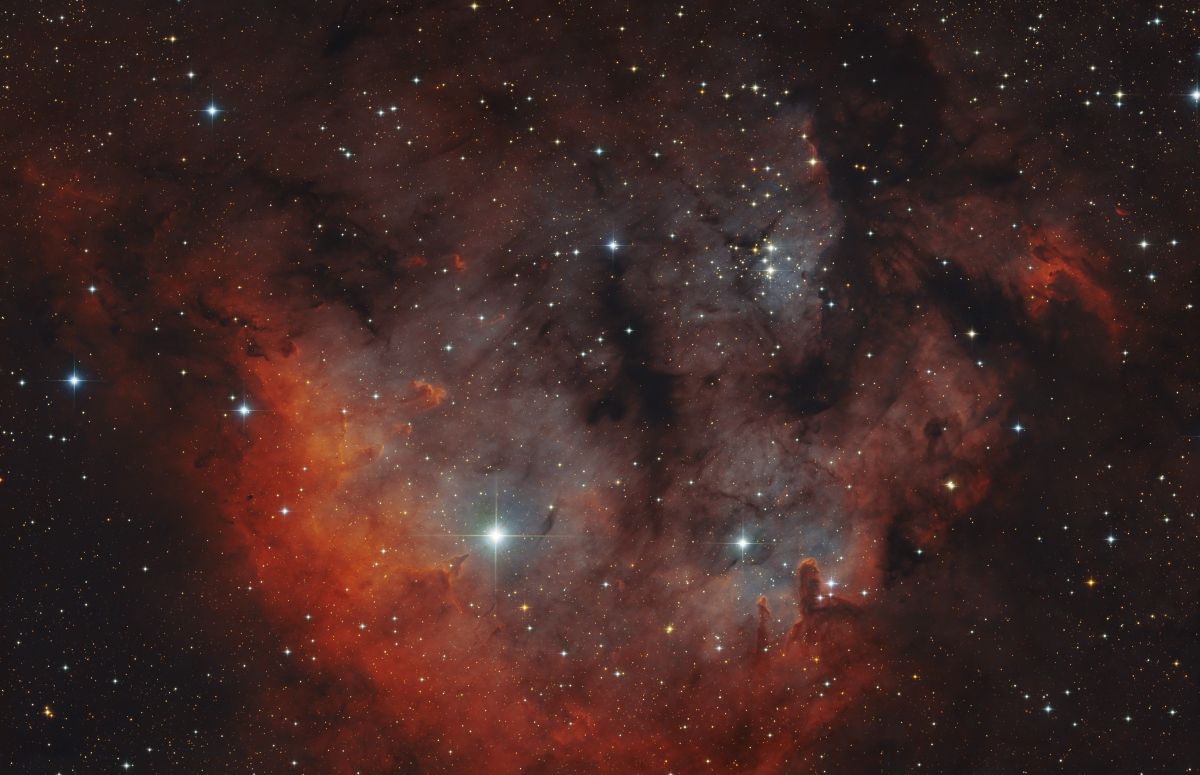
[back] NGC 7822 (The cosmic question mark) in Cepheus
| Higher resolved images / höher aufgelöste Bilder | Low-OIII Version (6690 x4589 Pixel) |
| High-OIII Version (4686 x 3025 Pixel) |

|
(c) 2024 All astro photo images are copyrighted. They may not be used or reproduced without explicit written permission from the authors. |
|
300' |
|
About this Image / Über dieses Bild
| CCD: | ZWO ASI094MC Pro |
| Image Type, Orientation: | RGB-HaOIII Composite, North is at 12:15h |
| Exposure time: | RGB: 18x300s, Ha/OIII: 36x300s (4:40h total) |
| Exposure date: |
November 1st/2nd 2022 |
| Location: | Capella Observatory at Skinakas, Crete/Greece,robotic (with babysitting from Bad Arolsen/Germany) |
| Filter: | RGB: Internal Bayer-Matrix, HA/OIII: STC Astro Duo-Narrowband Filter |
| Instrument: | Ganymed 60cm-Hypergraph in primary focus (f=1840 mm) |
|
Image seeing (FWHM): |
1.9" |
| Photographer: | Josef Pöpsel, Frank Sackenheim, Stefan Binnewies |
|
Remarks: |
NGC 7822 is known by the trivial name "The cosmic question mark". It is a
rather large gas nebula in the constellation Cepheus. Our image shows the
central part of the nebula, which is also cataloged as Sh2-171. The whole
nebula is stimulated to glow by the stars of the star cluster Berkeley 59, a
fairly young star cluster from a cosmic point of view. The light from the
cluster stars appears slightly reddish in color here, although young stars
predominantly glow blue. This is due to the so-called extinction, which is
caused by dust. NGC 7822 is a prime example of a cave-shaped emission
nebula. You can clearly see molecular clouds in our image, similar to the
Pillar of Creations. These all point towards the source of ionization, the
star cluster. A wider field of this region, exposed through the Lichtenknecker 12"-FFC in 2011 can be found here. |
|
Bemerkungen: |
NGC 7822 ist unter dem
Trivialnamen „Das kosmische Fragezeichen“ bekannt. Es handelt sich um einen
recht groß am Himmel erscheinenden Gasnebel im Sternbild Cepheus. Unsere
Aufnahme zeigt den zentralen Teil des Nebels, der auch als Sh2-171
katalogisiert ist. Der ganze Nebel wird zum Leuchten angeregt durch die
Sterne des Sternhaufens Berkeley 59, kosmisch betrachtet ein ziemlich junger
Sternhaufen. Das Licht der Haufensterne erscheint hier leicht rötlich
gefärbt, obwohl junge Sterne überwiegend blau leuchten. Grund ist die
sogenannte Extinktion, die durch vorgelagerten Staub hervorgerufen wird. NGC
7822 ist ein Paradebeispiel für einen höhlenförmigen Emissionsnebel. Man
erkennt in unserem Bild deutlich Molekülwolken, ähnlich den Pillar of
Creations. Diese zeigen alle zur Ionisationsquelle, dem Sternhaufen, hin. Ein weiteres Feld dieser Region, aufgenommen 2011 durch ein Lichtenknecker 12"-FFC ist hier zu finden. |
Back to the Diffuse Nebulae Overview / Zurück zur Diffuse-Nebel-Übersichtsseite